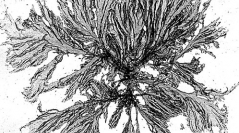

 Cryptogamie, Algologie
25 (3) - Pages 275-290
Cryptogamie, Algologie
25 (3) - Pages 275-290The marine red alga Dudresnaya abbottiae Afonso-Carrillo et Tabares sp. nov. from the Canary Islands is described. The new species has no single unique feature, but differs from the other Dudresnaya species by a distinctive combination of attributes. Gametophytes are radially branched with terete, nonannulate young branches, crystalline inclusions are lacking in axial cells, outer cortical cells are cylindrical, and rhizoidal filaments cut off from proximal cells of the cortical filaments reach 20 μm in diameter, regularly giving rise to terminal adventitious cortical fascicles. Spermatangial mother cells occur in paniculate clusters on outer cortical cells. Carpogonial and auxiliary-cell filaments lack a thick mucilage coat, generative auxiliary cells are distinguishable from adjacent cells before contact with a connecting filament, cystocarps are loosely constructed, and carposporangia completely surround the auxiliary-cell filament. The most closely related species to Dudresnaya abbottiae appear to be D. babbittiana Abbott et McDermid from the North Central Pacific, D. capricornica Robins et Kraft from Australia and the Arabian Sea, D. kuroshioensis Kajimura from Japan and D. canariensis Tabares, Afonso-Carrillo, Sansón et Reyes from the Canary Islands. Although all these species show important similarities in overall habit and shape of outer cortical cells, the arrangement of spermatangial mother cells and the morphology of rhizoids, generative auxiliary cells and cystocarps distinguish them. A synoptic key to the nineteen species currently included in the genus Dudresnaya is given.